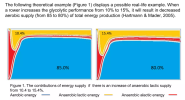You are using an out of date browser. It may not display this or other websites correctly.
You should upgrade or use an alternative browser.
You should upgrade or use an alternative browser.
Is anaerobic training totally crazy?
There's a lot of performance potential to be found in this energy system. All CP or all aerobic is a pendulum swinging (over)reaction to all metcons all the time.Wow, Pavel agrees with me, this is amazing. Look at what he wrote last year:
'Anaerobic glycolysis is the sugar burning that supplies faddish “high intensity interval training” and “metcons.” This highly inefficient process pollutes your body with lactic acid, ammonia, and free radicals and messes with your hormones if you tap into it too much or too often.
A+A, in contrast, relies on the clean burning “rocket fuel” of creatine phosphate (CP) to power high intensity efforts and an equally clean aerobic system to replenish the CP.'
Training should be based off of goals, not energy system metaphors of good/bad. It also ignores the fact that all three energy systems are being used simultaneously - what changes in duration of activity is the relative contribution of energy to the task.
Before throwing out one energy system it might be best to take time to understand why it is there and what is used for. Lactate is an incredible source of energy, and being able to efficiently operate anaerobically outside of that 10-15s window is huge. Pavel doesn't throw out training this system, but from my understanding he/SF use "tactical" implementation of glycolytic training that relies on on a base built on nonglycolytic training.
We have the luxury of contemplating concepts like this because we don’t have to use the anaerobic energy pathway on a regular basis. Increased fitness for survival to reproduce doesn’t necessarily equate to longevity and greater health span, but by golly, when you need it, you need it.
When trained and dosed accordingly, I’m sure it can support health span along, and I’d say most complete train programs must have some element of this on occasion. I’ve overdosed it for periods of time and burned out, so lesson learned.
When trained and dosed accordingly, I’m sure it can support health span along, and I’d say most complete train programs must have some element of this on occasion. I’ve overdosed it for periods of time and burned out, so lesson learned.
Dydo
Level 5 Valued Member
I am not competent to talk about energy systems of the body. All I can say is that bodybuilding style training did not improve my performance in any way when, for example, I had to carry loads for 10-15 min or more. In the beginning, I lift heavier objects than other porters and demonstrate more strength , but very quickly after that I'm tired. And if the load cannot fit in the elevator and I have to climb stairs, it gets even worse. I'm fine, but for a weight lifter it's ridiculous. I think I said it a while ago, but in the television formats in my country, where there are competitions involving agility, speed and a lot of strength endurance, the most muscular are eliminated first. For example, a bodybuilder was destroyed in a handsaw cutting competition in which his opponent looked like a cynic and was not a professional athlete.
IMO, about 20% of your training should involve getting smoked.
North Coast Miller
Level 9 Valued Member
This would be some outdated thinking, what pollution or problem are we talking about here? Improved insulin sensitivity, increased hypertrophy, "lactate's role in mediating brain function. These canonical function involves learning and memory, cerebral blood flow, neurogenesis, and cerebral microangiogenesis, energy metabolism, neuronal activity, and neuroprotection. Therefore, lactate is competent to be a potential therapy for ameliorating the pathological process of some brain diseases associated with impaired brain function."Surely that "91% anaerobic" you are talking about here is the ATP-CP system (which I believe can be replenished by the aerobic system), not the disgusting polluting anaerobic glycotic system which we're talking about as the problem from the first post
The basis for this conversation is based on flawed understanding of the subject.
nickster
Level 1 Valued Member
dmaxashman, I appreciate your sense of humor.
"...the disgusting polluting anaerobic glycotic system which we're talking about as the problem from the first post..."
As if one of the body's multiple miraculous ways of converting food into energy is disgusting
Like everything else, use it or lose it.
"...the disgusting polluting anaerobic glycotic system which we're talking about as the problem from the first post..."
As if one of the body's multiple miraculous ways of converting food into energy is disgusting
Like everything else, use it or lose it.
North Coast Miller
Level 9 Valued Member
"Too much or too often" are the important take-aways here.Wow, Pavel agrees with me, this is amazing. Look at what he wrote last year:
'Anaerobic glycolysis is the sugar burning that supplies faddish “high intensity interval training” and “metcons.” This highly inefficient process pollutes your body with lactic acid, ammonia, and free radicals and messes with your hormones if you tap into it too much or too often.
A+A, in contrast, relies on the clean burning “rocket fuel” of creatine phosphate (CP) to power high intensity efforts and an equally clean aerobic system to replenish the CP.'
And CP is far from consequence free. It is now understood to be the prime reason for decrease in contraction force due to fatigue - accumulation of inorganic phosphate, not ROS, lactate, or lowered pH. Is more important to focus on adaptive response to training strategy than theoretical metabolic shortcomings of sub-exhaustive energy utitization. Results speak for themselves, both in exercise science and biology.
"Some early studies conducted more than 10 years ago showed that acidification, if anything, resulted in an increased tetanic force at physiological temperatures"...
"Creatine has little effect on contractile function, whereas there are several mechanisms by which increased Pi may depress contractile function. Thus, on the basis of recent findings, increased Pi rather than acidosis appears to be the most important cause of fatigue during high-intensity exercise."
Adachi
Level 7 Valued Member
And interestingly inorganic phosphate seems to be associated with bone health"Too much or too often" are the important take-aways here.
And CP is far from consequence free. It is now understood to be the prime reason for decrease in contraction force due to fatigue - accumulation of inorganic phosphate, not ROS, lactate, or lowered pH. Is more important to focus on adaptive response to training strategy than theoretical metabolic shortcomings of sub-exhaustive energy utitization. Results speak for themselves, both in exercise science and biology.
"Some early studies conducted more than 10 years ago showed that acidification, if anything, resulted in an increased tetanic force at physiological temperatures"...
"Creatine has little effect on contractile function, whereas there are several mechanisms by which increased Pi may depress contractile function. Thus, on the basis of recent findings, increased Pi rather than acidosis appears to be the most important cause of fatigue during high-intensity exercise."

Inorganic phosphate as a signaling molecule: a potential strategy in osteosarcoma treatment - PubMed
Inorganic phosphate (Pi) is an essential nutrient to living organisms. It plays a key role in diverse biological processes, including osteoblast differentiation and skeletal mineralization. Maintenance of proper Pi homeostasis is a critical event, as any deviation from that state can lead to...
watchnerd
Level 8 Valued Member
The only time you need this dumb anaerobic glycolysis system is for max efforts of 30 seconds. That is totally crazy. Almost no sport that people actually care about has plays like that except for maybe UFC.
Rowing. Elite 2000m rowing times for men are <6 min.
Over the course of the race, it's about 10-15% glycolitic, lower is better, but it can't be eliminated under race conditions.


Metabolic requirements for energy in rowing
Metabolic requirements for energy in rowing - Download as a PDF or view online for free
Last edited:
Kepsekajse
Level 2 Valued Member
Your overthinking this. Just exercise. Different people have different goals, if you don't want to do anaerobic training then don't. Its not dangerous or ineffective. Elite athletes in various different fields do it.
timmothysmith01
Level 2 Valued Member
Anaerobic training isn't crazy! It helps with explosive power and quick bursts of energy for sports.
North Coast Miller
Level 9 Valued Member
Important to note they distinguish between anaerobic lactic (fast twitch) and aerobic (slow twitch). Pyruvate is undoubtedly higher than 10 or 15% contribution at a racing pace, still aerobic. IIRC on an older thread it was posted that competitive rowers had the highest % of type 1 fibers by total than any other sport specific athlete that had been tested.Rowing. Elite 2000m rowing times for men are <6 min.
Over the course of the race, it's about 10-15% glycolitic, lower is better, but it can't be eliminated under race conditions.


Metabolic requirements for energy in rowing
Metabolic requirements for energy in rowing - Download as a PDF or view online for freewww.slideshare.net
dmaxashman
Level 5 Valued Member
We have the luxury of contemplating concepts like this because we don’t have to use the anaerobic energy pathway on a regular basis. Increased fitness for survival to reproduce doesn’t necessarily equate to longevity and greater health span, but by golly, when you need it, you need it.
When trained and dosed accordingly, I’m sure it can support health span along, and I’d say most complete train programs must have some element of this on occasion. I’ve overdosed it for periods of time and burned out, so lesson learned.
I'm going to paraphrase this post: "I've done anaerobic training before and had terrible results. But it must be important and people should keep using anaerobic training."
dmaxashman
Level 5 Valued Member
A person can only do so much training. And this is especially true for athletes who care about results. Anaerobic training is most taxing, destroys the body, and significantly limits the amount of other training an athlete can do. So "use it or lose it" in this context actually has a very different meaning then what you intend: this terroristic training forces an athlete to lose out on their more important training.dmaxashman, I appreciate your sense of humor.
"...the disgusting polluting anaerobic glycotic system which we're talking about as the problem from the first post..."
As if one of the body's multiple miraculous ways of converting food into energy is disgusting
Like everything else, use it or lose it.
dmaxashman
Level 5 Valued Member
Really have you ever seen a football player do a 30 second explosive play? How many seconds does it take LeBron James to fake one way, dribble to the hoop and slam dunk, is that a 45 second move?Anaerobic training isn't crazy! It helps with explosive power and quick bursts of energy for sports.
Explosive movements take a few seconds to do. Anaerobic activities that take 40 seconds to do are surely taking away from true quick explosive and powerful movements.
North Coast Miller
Level 9 Valued Member
* facepalmAnaerobic training ...destroys the body
... this terroristic training forces an athlete to lose out on their more important training.
Rowing. Elite 2000m rowing times for men are <6 min.
Over the course of the race, it's about 10-15% glycolitic, lower is better, but it can't be eliminated under race conditions.


Metabolic requirements for energy in rowing
Metabolic requirements for energy in rowing - Download as a PDF or view online for freewww.slideshare.net
I like this representation:

However, so much more to say about it than what they say in the text above it.
One thing is, we can train below the aerobic threshold; on the left side, at 85% or perhaps just under it, and hardly use glycolysis at all. This is MAF - maximum aerobic function training, also called Long Slow Distance (LSD), Long Easy Distance (LED), Low Intensity Steady State (LISS), and "zone 2 cardio."
I think the most important points are that as one trains to increase aerobic capacity, they are more able to do the left side -- which is more efficient, less stressful at the same power as the right side, AND has a greater overall potential for more power than is shown, or than the right side, because they can add more glycolytic energy on top of that to go even harder/faster. And the more one trains this, the more total power they can produce with the "blue engine", and for more total time (endurance).
The text in the top of the slide "when a rower increases the glycolytic performance from 10% to 15%" is confusing, IMO, because this is neither something we can choose to do NOR something we normally train to TRY to do. Although if we train frequently in glycolysis, perhaps the body preferentially goes there. I've heard that argued, though I don't know if it's really true. At the very least, it may neglect further developing the aerobic system if we are frequently stimulating and developing the glycolytic path.
And I guess that last sentence is what addresses the original post.
However, from the OP:
You can see that this isn't true. We can use it continuously for hours, as the picture above shows. It supplements the energy needs that exceed the aerobic system. I do it every weekend on my 2+ hour bike ride. I'm riding a little harder than MAF, which would be blue. Glycolysis is kicking in the difference so I can work a little harder. But I stay below the lactate threshold, which would force me to slow down. Though that actually happens time and time again on a hill or hard effort. You can feel yourself exceed the threshold, things get hard, you are forced to slow down a bit.The only time you need this dumb anaerobic glycolysis system is for max efforts of 30 seconds.
Now, moving into a different way of looking at things. "Anaerobic training" can also refer to short hard efforts like sets of kettlebell lifting, barbell lifting, sprint training, Airdyne sprints, or so many other things. It refers to this:
The first part of the effort before the aerobic system really kicks in. Obviously, we do LOTS of strength and power training activities in this area. So yes, of course it is very useful.
What happens after the set? You recover PCr (the red) -- aerobically (blue). The chart isn't showing recovery, though. It's showing expenditure.
Then we essentially get ourselves recovered and reset back to the beginning, so we can do that hard "anaerobic" set again.
Justin_M
Level 6 Valued Member
I think it might be beneficial to clarify anaerobic containing both lactic and alactic energy. I think the identification of what phases of energy production are required for an event are critical to address the needs.
- Alactic power, <7"
- Alactic capacity, 7-15"
- Lactic power, 15-30"
- Lactic capacity, 30-60"
- Aerobic power, 1-3'
- Aerobic capacity, >3'
ali
Level 7 Valued Member
The OP....as said, the issue is frequency and duration forming the 'dose'.
Another way to off set the response to max or sub max work is to use long rests or very long rests in some cases. SF approved by Pavel here:

I get your confusion. High power with long rests is the recipe for anaerobic power pursuits like sprinting. You can also sprint with short rests. No right or wrongs just appropriate for your goals and training. The issue is turning everything into a vomit fest. That's not the SF way but anaerobic work is all part of the adaptive training process. Different models apply....and yes that can appear confusing and can be presented as a binary choice sometimes.
Another way to off set the response to max or sub max work is to use long rests or very long rests in some cases. SF approved by Pavel here:

"Long Rests": A Revolution in Interval Training | StrongFirst
Not long ago, my father and I were having a typical conversation about rest periods between sets. The Russians have long known what many these days forget.
www.strongfirst.com
I get your confusion. High power with long rests is the recipe for anaerobic power pursuits like sprinting. You can also sprint with short rests. No right or wrongs just appropriate for your goals and training. The issue is turning everything into a vomit fest. That's not the SF way but anaerobic work is all part of the adaptive training process. Different models apply....and yes that can appear confusing and can be presented as a binary choice sometimes.
